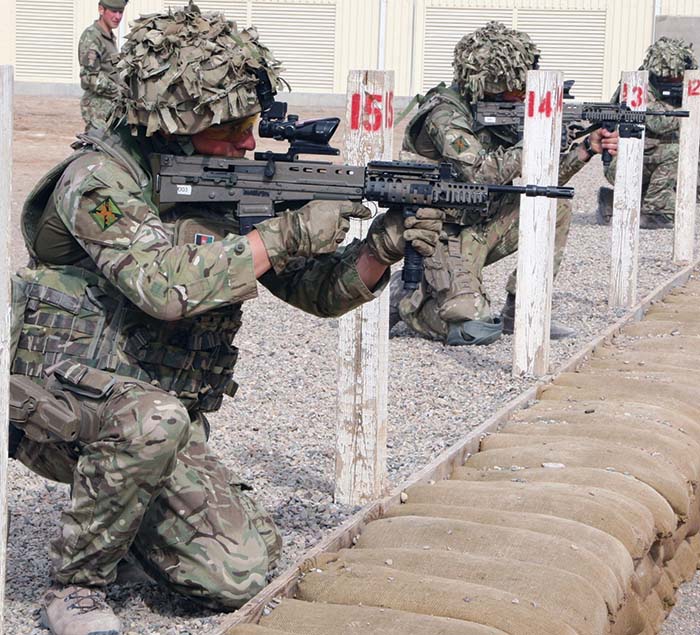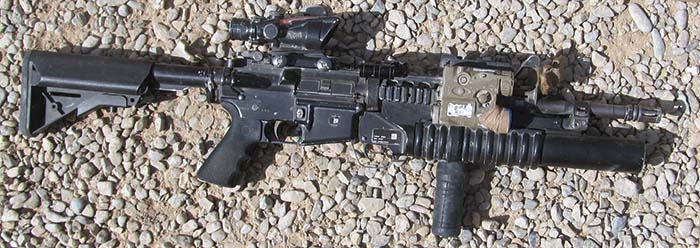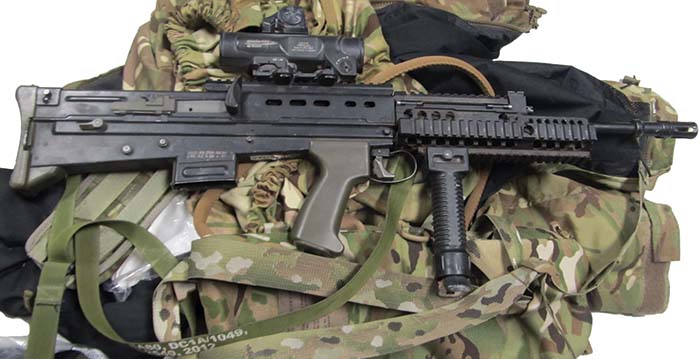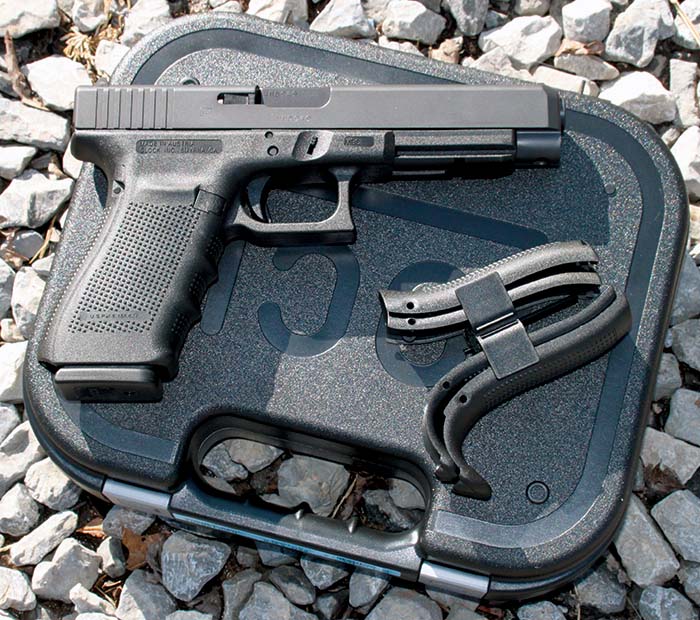Here one can observe the BlackHawk! SERPA thigh holster that Marines are currently being issued, and can compare that to the British Radar thigh holster setup for a Glock 17.
By Miles Vining
“The second you stop learning, is the second you start dying” is a phrase that the author used when talking to Afghan National Army soldiers while teaching a counter IED (Improvised Explosive Devices) class in Helmand Province, Afghanistan. The point to be made was that in an IED environment, a soldier’s most important asset is his mind and how he solves or predicts certain situations. This maxim can be applied to anything involving life or death with military, law enforcement or civilian applications.
Soon after, the author took advantage of an opportunity to fire some of the small arms belonging to our allies across the pond while being forward deployed to Camp Leatherneck (British Bastion, Afghan Shrobak are joint bases).
The author took this opportunity as a means to examine the differences between the British Army’s and U.S Marine’s small arms approaches. How the two countries view safety, range operations, shooting qualifications, and immediate action procedures. Although Marines are known for their ability to “improvise, adapt, and overcome,” much of the service is very regulation bound, and outside the box thinking is often met with severe criticism and disdain by higher echelon leadership. This would seem surprising considering Marines are at the forefront of Combined Arms warfare, amphibious operations, and low intensity conflict. The ever-changing theory and innovative strategy is present, but within individual units, officers and senior enlisted possess an attitude of, “This is the Marine Corps way, and nothing else works as well.” Some of that is certainly “esprit de corps” but a lot of it is narrow mindedness and unwillingness to accept that there is always room to improve. This is quite troubling because if any organization is to succeed, it has to be fluid with the changes occurring in its environment and maintain an open mind about what works and what doesn’t. As an example, infantry Marines know their internal weapon systems to the point of muscle memory. But knowledge of their allies or enemy’s weapon systems is immensely limited. There are Foreign Weapons Instructor courses offered in Quantico but these are small in number and are mostly attended by Marines in an instructing position, and not the typical sergeants and corporals leading squads into combat. The underlying message in this essay is to keep an open mind and not let rigid standards prevent becoming more knowledgeable about what is out there, both bad and good.
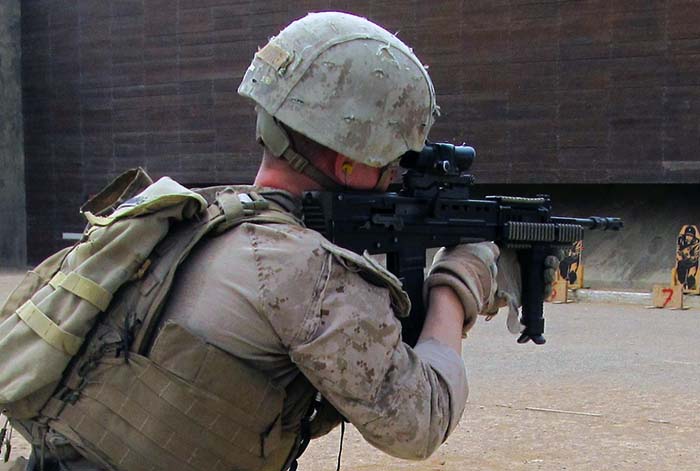
Adopted as the national service rifle in 1987, and replacing the L1A1 FN FAL, the SA80 (Small Arms of the 1980s) got off to a rocky start in terms of reliability. British troops in the first Gulf War were taping their handguards up to prevent jams from the ever present sand. Some of these issues were due to the fact that the SA80 had been intended for use in a land war in Europe, and not in the Middle East. The problems continued until the late 1990s, when the SA80 and Heckler & Koch metaphorically saved each other. Heckler & Koch was going through a financial crisis and the SA80 seemed to have no reliable version in sight. Heckler & Koch took up a modification contract, which culminated in the L85A2 and L85A3 versions of today (same rifle but re-designated L85). These are currently in use with all of the British Forces and have several variant offshoots in shorter carbines, single fire cadet rifles, and the LSW (Light Support Weapon).
One fact that is often omitted about the rifle is that it gave the United Kingdom (an army to be reckoned with), a service rifle with magnified optical sights. Of course Austria had the Steyer AUG with its optical sight in 1978 but the Austrian army doesn’t deploy internationally as much as the UK does. To put this in perspective, the U.S. Marine Corps didn’t begin fielding optical sights until Operation Iraqi Freedom in 2003 and even that was as a single designated marksman in every rifle squad. The rest of the infantry had to wait as late as 2005 (seventeen years after the SA80) to have the 4x Trijicon ACOG (Advanced Combat Optical Gunsight), RCO (Rifle Combat Optic). The U.S Army was on a similar schedule. Today, almost every modern army has optical sights on their service rifles, even some third world armies as well.
The course of fire and the range were very simple; some basic combat marksmanship drills, shooting from the prone, kneeling, and standing, on the move and from different yard lines within the 36 yard range. The author fired two full magazines through the L85A2 and a magazine through the Glock – nothing too strenuous or torture testing due to the range and time constraints. The conduct of the range was professionally administered and very well disciplined. This was done in a subtle manner unlike many Marine ranges where conduct is strictly controlled. Even though commands were simple, safety was very much paramount and at no time was an unsafe act allowed to continue.
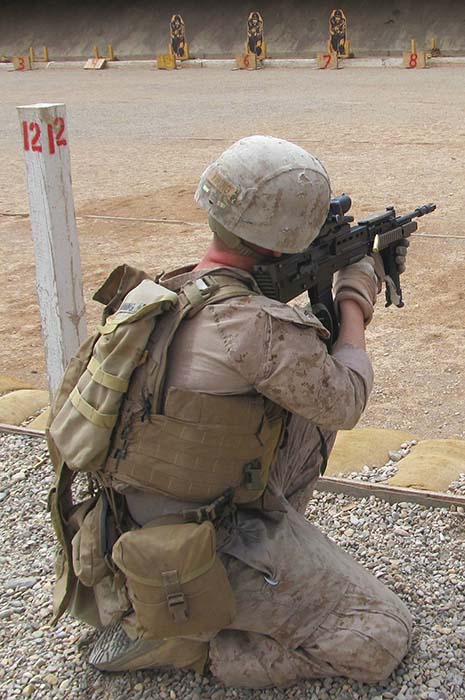
The L85A2 fired was by all means a modern rifle compared to the original SA80, apart from the original SUSAT (Sight Unit Small Arms, Trilux) sight. Most of the British infantry that go outside the wire are equipped with the Trijicon ACOG or an Elcan sight but the rear echelon soldiers have the old SUSAT. Apart from that, the rifle has a full spectrum Picatinny rail system as the handguard, grip pod, and Magpul Emags are issued out en masse. The sling is a thin webbed green type that is used mostly in a garrison environment. On patrol, plastic clips are issued and the rifle can be clipped to an Osprey (British flak jacket) – in other words making it a One Point sling. The rifles on Bastion have a black finish but this is painted over with a light tan that stays on though rifles in theater for a good period of time are seen with this starting to wear off.
Being a bullpup, the rifle itself is very compact with a full length barrel, and its width is noticeably thin, compared to an M16/M4. This translated into being able to get a very tight stance. It is very appreciable for offhand shooting and urban operations. The tighter a shooter can be with his rifle, the more control he can exert over its effects at a close range. This was especially evident at the 36 yard line where impacts could be seen instantly. Using the SUSAT (reticle is a single triangular post), point of aim was point of impact with the scope set on the 300 meter Battle Sight Zero setting. To adjust for further distances, the shooter must manipulate the dial to the correct yard line. Adjustments go up to 800 meters and there are peep hole iron sights on top of the scope while the Trijicon and Elcan optics, a Ruggerized Miniature Reflex (RMR) sight is present. To gain proper eye relief the shooter must place his eye more or less on the scope. And what of scope bite? On the SUSAT there is a rubber fitting that prevents any. With about an inch of relief of the soldier shooting the author’s M4/M203, there was a slight learning curve because this rubber ring isn’t on an RCO (Rifle Combat Optic).
The Grip Pod was useful but the author’s personal opinion on the Grip Pod is quite negative, nothing to do with the L85A2 but his own experiences with it as a Marine. It’s too large/bulky as a grip and too fragile as a bipod. It’s great for resting the weapon, but using it as a legitimate field bipod in the rough, unforgiving environment of a firefight or truly rough range use, the author found it too fragile. The legs had a tendency to snap under pressure.
Operating the SA80 is rather straightforward but a little awkward if someone is very M16/M4 controls minded. To chamber a round, the shooter must first insert the magazine. Being a bullpup, this is a different affair than an M16/M4. British doctrine dictates that the right hand must always be on the pistol grip, a very sound principle realizing that Marines have the same one but in using an M16/M4 sometimes one must use his right hand for manipulation. Tilting the rifle to the right, the shooter inserts a magazine, then tilting it the opposite direction to the left, the shooter then charges the rifle with the left hand on the cocking knob. There is no left handed configuration; all recruits are trained to be right handed with the rifle. A good tap is then required when the knob has gone fully forward, similar to tapping the forward assist on an M16/M4. Here is an issue from a tactical perspective; most of this requires the shooter to break his hold to the target, even if he is physically looking at the target, the rifle must be tilted this way and that and is not pointed where he is looking. Unlike M16/M4s where a shooter can complete most operations without even breaking a cheek wield. Of course after much training and familiarization a shooter could get to a point where he could manipulate the rifle fast enough to get it back up in the case of a stoppage or empty magazine.
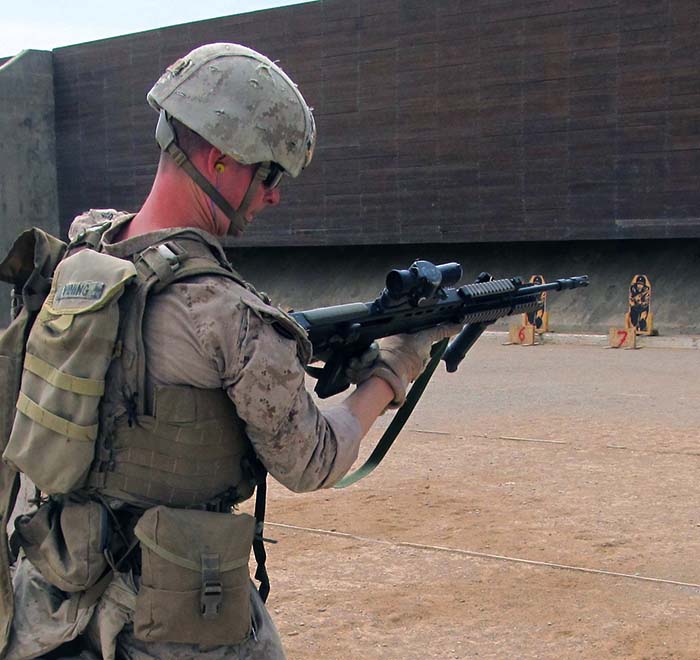
For immediate action procedures, the British SOP (Standard Operating Procedure) is advantageous over the Marine one. Since basic training many Marines have it drummed into their heads the phrase “Tap, Rack, Bang” when dealing with a misfire. In technical terms, this means to tap the bottom of the magazine with the free hand, rack the charging handle to the rear, and then attempt to fire. This is an excellent remedy apart from one often-omitted necessary step. An instructor will always be sure to teach that immediate action requires; observe for feeding and ejecting, then move to “Tap, Rack, Bang.” The British procedure cuts to the source of the malfunction; if encountering a stoppage, tilt the rifle to the left, retract the charging knob and view the chamber. This immediately forces the shooter to confront the malfunction. It may just be an empty magazine or it may be a double feed, but the point is the shooter is looking directly at the problem instead of possibly making it worse by executing “Tap, Rack, Bang.”
Firing the L85A2 is just like any bullpup, the largest obstacle is the trigger. The trigger itself does not have a heavy pull; it is a two stage military trigger with slack taken up about 2/3 of the way back. The issue is the reset time. A shooter has to almost release his finger the entire length of travel for the trigger to reset to the hammer in order to get off the next shot. If the reset has not completed, that next shot cannot be made until the trigger is released the full length. Once again, with constant training this issue will go away, but from a shooters perspective, studying the rifle in general, the author found the trigger to be lacking.
When the bolt is locked to the rear after the last round, the charging knob is visibly locked to the rear in the corner of the shooter’s right eye. This was a comfort compared to an M16/M4 where if a shooter is not carefully paying attention to the vibrations of the rifle, he can miss sensing the bolt lock back after the last round. The bolt locking levers are on both sides of the weapon, truly convenient compared to the M16/M4 where the release catch is only on the left side. Similar to a Tavor, the release catch can be depressed by the same hand that inserts a fresh magazine.
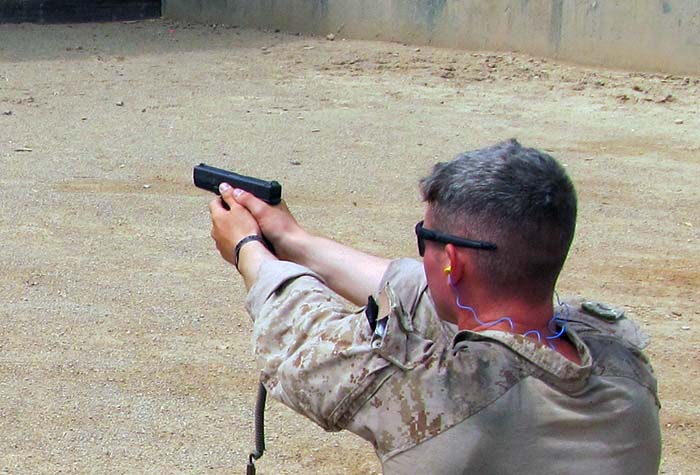
Also fired was the 9x19mm Glock 17, now in service as the primary sidearm (secondary being the SIG Saur P226) to replace the FN Hi Power (there are still a few Hi Powers in use on Bastion, mostly with rear echelon troops). The handgun itself was a standard Glock 17. Thus, the Glock will not be reviewed as its reputation is world renowned. But what is different are the operating procedures and holster. As a side note, the course of fire with a pistol involved a kneeling position, which is different from the Marine Corps’ pistol course, which is all standing.
Within the U.S. Armed Forces, the Beretta M9’s safety conditions are set upon the pistol, with magazine inserted, safety on, and round in the chamber all various safety measures. But with no external safety on the Glock, the British have to improvise. With a magazine inserted, no round in the chamber, the pistol inserted in the holster is itself considered a safety feature. Once drawn, the pistol has now been raised to an elevated safety level, racking the slide brings it to the final condition before firing. Inserting the pistol back in the holster brings the condition back down.
The holster in use is certainly a wise choice. When the MoD (Ministry of Defence) adopted the Glock 17, it also adopted the Radar 1957 (listed as 6661 Safe & Fast Index holster) Level 3 holster set as well. This is a small company that has its product made in Italy. In comparison to the U.S. equivalent, the BlackHawk! SERPA, the Radar offers some distinct advantages. The UK also issues SERPA holsters but only for soldiers armed with the SIG Sauer P226. The reason behind comparing the Radar 1957 to BlackHawk! specifically and not Safariland or other holster brands in use is because service wide, the SERPA is the most thoroughly issued out and used personally by those with Berettas signed out to in the U.S. Armed Forces.
Both holster systems are designed to have rotating angles of draw and both are made in sets with different cradles intended for thigh, hip, and chest/flak mounted carry. This is to facilitate wearing the pistol in a garrison setting without body armor on. But if the user dons his flak, he can easily transition his holster from a thigh/hip mount to a flak mounted one, as some prefer to have the handgun high up on their chest while burdened down with gear. This makes for drawing a handgun in confined spaces such as in the turret of an American MRAP or British Foxhound more accessible. The difference between these two locking systems is quite noticeable; the Radar 1957 is much more robust than the SERPA. The Radar 1957s locking cradle is permanently attached to the mount, and the holster locks in via a built up circular device. The SERPA on the other hand, is held in place by two rotating pieces of plastic in its cradle. The cradle is secured to the mount via three Phillips head screws.
In retention though, SERPA is faster in drawing; it already has a good reputation and that is primarily what it is based on and founded upon. This retention system is dependent on a single swivel that locks the trigger guard into place; otherwise no other lock is present. The swivel is also about the size of a quarter. The holster is also very exposed with the muzzle portion completely open. The Radar’s retention system is a two stage. The first is activated by the firing hand thumb to release the slide lock and the second is operated by the trigger or middle finger to release the pistol itself. Although slower initially, with training the speed can be brought up to that of the SERPA. The Radar 1957 also exposes the pistol less and is a two stage retention system but most of the pressure is more on the shooters middle finger. Instead of the SERPA, all the pressure is on the trigger finger during the draw. From a safety perspective, this is perfect, one can draw the Radar all day without worrying about a negligent discharge; but although the SERPA is quick, the retention isn’t as impressive.
At the conclusion of the shoot, the author was extremely satisfied having gained valuable experience shooting and learning about his counterpart’s weapon systems. But more importantly he was learning about how another military operates different from his own, because the second you stop learning is the second you start dying.
| This article first appeared in Small Arms Review V19N1 (January 2015) |



